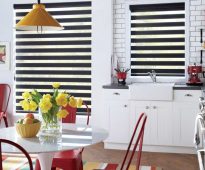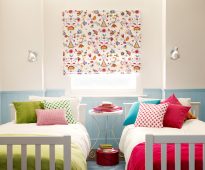Types of thick curtains for the bedroom: fabrics, tips on choosing
Thick curtains - the most common option for window decoration. It's all about their practicality. They will protect from excessive light in the summer, they will not let the cold out of the street in the winter and will securely hide the room from the view from the street. Without them, the room looks uncomfortable and a bit official. Thick curtain fabric is a great decoration for any home.
Blackout curtains for windows are popular at any time of the year.
Content
- 1 Thick, night curtains: description
- 2 Varieties of ready-made thick curtains
- 3 Fabrics for heavy curtains
- 4 How to sew drapes on the lining?
- 5 The best photos of the design of the bedroom and other rooms with heavy curtains
- 6 VIDEO: Options for curtains for the bedroom.
- 7 Blackout curtains in the interior - 50 modern ideas:
Thick, night curtains: description
Night curtains - the necessary solution for the bedroom. After all, the quality of sleep depends on the health, mood and efficiency of a person. Bright sunshine, street noise can prevent sleep. The problem is solved by a thick curtain, which is often called a curtain.
This is a stylish and convenient option for decorating the room, which helps to create a cozy atmosphere in the room.
Originally drapes were used to curtain the door passage. Heavy draperies protected the room from cold and noise. By the way, the name comes from the French “porte” - “door”.
As a rule, thick curtains are used in the bedroom, as they do not let in bright light.
The dense portieres have many practical functions.
- Protect the room from light.
- Reduce the noise penetrating from the street.
- Do not let the cold air through.
- Prevent the ingress of dust coming from outside.
- Hide the room from prying eyes.
Hanging such curtains on the windows, you can be sure that your room will become much more comfortable.
Varieties of ready-made thick curtains
In addition to the classic curtains, there are other design options for thick curtains.
- Roman. Direct canvas, which is controlled by a special mechanism.
When lifting, uniform transverse folds are formed.
- Double curtains. Thick curtain, which consists of two canvases, located on top of each other. Due to the double layering can create a good level of shading. Another plus is that they can be bilateral.
It is so easy to change the design in the room without any extra money.
- Cloth blinds. It can be applied to any room: hall, kitchen, bathroom, study, arbor.
Relatively inexpensive option for shading rooms.
- Roll curtain. It is a very simple and convenient design. Consists of a smooth blade and shaft.
When raised, the rotating mechanism winds the web onto the shaft.
Curtains with heavy texture are practical and versatile. Best of all with the task of blackout they cope in the bedroom. But for other rooms you can choose your own version of opaque textiles.
Blackout curtains are used in the bedroom as they do not let in bright light.
Hall. Massive curtains are plain, dense in texture and rich in textiles suitable for a spacious hall. Draperies and decorative details are allowed here: brushes, tacks, pelmets, folds and lush assembly.
The curtains will detain not only the light coming from the street, but also noise and even cold air.
Children'sCurtains for a quiet baby sleep should be soft, but at the same time they are well delayed light. Design - simple, without folds and complex draperies. It is important that the opening and closing mechanism is uncomplicated for the child.
In the summer of these blinds will save from the heat.
Kitchen. Here it is better to choose shortened versions of curtains: Roman, rolled, "cafe", Austrian or French.
Buying curtains, you need to focus on their density.
Fabrics for heavy curtains
Many housewives are interested in the question: what are the curtains made of? After all, the variety of materials offered by manufacturers today is very large. The night curtain is not sewn from any fabric you like. It is necessary to select a material that will meet several requirements at once.
- High density.
- Durability and wear resistance.
- Easy care.
- Good shading ability.
- Resistant to UV rays.
Depending on the chosen material, you can get a more dense fabric, or vice versa, slightly translucent.
All these conditions correspond to several types of materials, which are mainly used for sewing window textiles with black out function.
Jacquard. Fabric with a special, thick weave. On a smooth background there is usually a textured ornate pattern. It is obtained by the interlacing of fibers of different thickness.
The material has high strength and resistance to fading.
Black-out. Originally blackout webs were used for cinemas and hotels. But thanks to the ability to 100% shade even on the sunny day, they were used to decorate the windows of apartments. The structure of the material is multi-layered. Synthetic fiber, polyester. Sometimes metallized spraying, acrylic or polyvinyl chloride layers are used for production.
Taffeta. High-density glossy fabric. Differs silk iridescent. Due to its structure, it makes it possible to make folds with expressive wrinkles and beautiful draperies.
Linen. If you choose a natural material, it will last a long time (up to 50-60 years), will become a natural antiseptic and improve the microclimate in the room. But flax has drawbacks: it is easily wrinkled and difficult to iron, the material shrinks after washing, the price for natural flax is high.
For tailoring curtains, flax is taken of the highest density.
Chenille Variety of jacquard. Its main feature is a complex weave pattern. It is made from fleecy, combed threads. It has excellent noise and light absorbing properties, as well as increased strength and wear resistance. Very soft, elastic material which is almost not rumpled and easy in leaving.
Velvet. Today, long-forgotten velvet curtains are coming into fashion. On the front side they are covered with a short nap. If the material is of high quality, the pile is thick and does not crumble.
Such curtains look expensive, so it is better to use them for window decoration of the hall.
In addition to the listed types of fabrics, others are also used: natural silk, wool, nylon, polyester, satin, satin, velor.
How to sew drapes on the lining?
Lined curtains are a low-cost alternative to black out textiles. They are better than single-layered, keep their shape. Resistant to fading, excellent blocking the penetration of light, will last more than one year. Sewn from two layers of fabric. The first is the front part of the curtains. The second is a lining layer, which protects from light, noise and cold.
The thickest curtains are used to protect from the sun.
Having the most basic sewing skills, you can sew dark, two-layer curtains for a nursery, bedroom or room for a newborn in several steps. That is, where there is a need for increased noise and light insulation.
Step 1. Choose a fabric
The footage of the fabric on the lining should be equal to the amount of material for the front of the product. The material for the lining we select monophonic, neutral tones: beige, cream, creamy, white.
Cream curtains are most often used to design bedrooms or living rooms in which you want to create a luxurious atmosphere.
Important! If you take a bright fabric or with a color print for the lining, the color of the front side may be distorted.
For the front we take a dark, dense, opaque texture. The classic version is a brown “face” and beige inside.
Artificial fibers for curtains are good in that they make natural fabric easier to care for and more elastic.
Step 2. We make measurements
Dimensions are determined using a measuring tape. We measure the height of the curtain from the eaves down to the desired length. If you plan the length of the curtains to the floor, then you need to take 1-2 cm from the measurement, so that later the canvas does not hang with an ugly harmonica and does not fray on the floor.
The width of the dense products is selected depending on how wide your window is and what the overall design of your room is.
Important! It is necessary to add 10 cm to the lower and upper edge of the curtains, total - 20 cm.
The width of the curtains is measured along the length of the eaves. The resulting value is multiplied by the assembly factor (CS) - from 1.5 to 3. The higher the CS, the richer the assembly will be in the end. For the side seams, add 5 cm (2.5 cm for each seam).
Note! The lining side should be cut to the bottom 10 cm shorter than the front. That is, for the lining side we make only one allowance for the upper hem.
Step 3. Tailoring dark thick curtains
Blinds should definitely go beyond the edges of the windows so that the light does not exactly penetrate the small gaps.
- Fold the front of the bottom edge of 2 cm, smooth down.
- Then we bend again, but by 8 cm. Smooth.
- Repeat point 1.2 with lining.
- Bleed the ironed seam of the front part with pins and make a straight line, departing from the inner edge of the hem 3-4 mm.
- Repeat point 4 for the lining part.
- We remove the pins and iron the seams.
- Fold the front part of the curtain face up. From above we put the lining part inside out up. In this case, the lining side should be shorter below than the front.
- We split the side parts with pins, make two side seams, departing from the edge of 2.5 cm.
- We remove the pins, twist the product from the inside out on the face, iron the sides.
- We fold the lower corners of the product into an “envelope”, manually fix the corners and sew the lining on the bottom, using a secret seam.
If you want to drape a wall with a beautiful fabric, it is better to take a big cut.
The top is made up depending on the type of fastening to the rail: curtain tape, drawstring, eyelets or hinges. The easiest way - "crocodiles", which work on the principle of ordinary clothes pegs.
The best photos of the design of the bedroom and other rooms with heavy curtains
Choose the best option for heavy curtains for different rooms will help photos of the best design ideas.
Curtains are a very significant part of the interior.
Curtains should fit into the overall concept of the room and blend well with other details in your room.
Depending on the color of your room, you can choose darker or lighter curtains.
They show that the dense texture not only helps to close the view from the street, to protect from light, cold and dust, but also looks expensive, luxurious and presentable.
VIDEO: Options for curtains for the bedroom.
Blackout curtains in the interior - 50 modern ideas:
 About roller blinds Day Night on plastic windows
About roller blinds Day Night on plastic windows
 Types of roller blinds in the nursery: for a boy or girl, photo
Types of roller blinds in the nursery: for a boy or girl, photo






